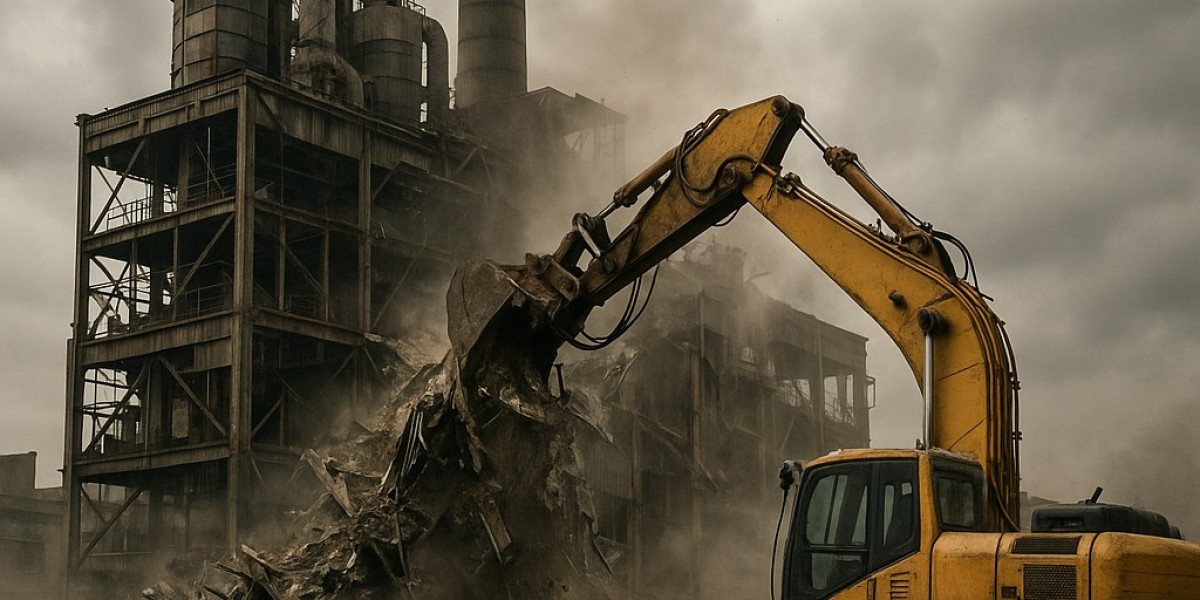Industrial demolition is a highly specialized branch of the demolition industry that involves the systematic dismantling or destruction of large-scale industrial structures and facilities. These can include factories, power plants, chemical plants, refineries, steel mills, and manufacturing complexes. Unlike residential or commercial demolition, industrial demolition requires meticulous planning, advanced machinery, and strict adherence to safety and environmental regulations.
What is Industrial Demolition?
Industrial demolition is the process of safely tearing down large and often complex structures used for industrial purposes. This includes the removal of structural components such as steel frameworks, reinforced concrete, heavy machinery, and hazardous materials like asbestos, lead, or chemicals. The process may also involve asset recovery, recycling of metals, site remediation, and preparing the land for future use.
Key Reasons for Industrial Demolition
Aging Infrastructure: Many industrial sites become obsolete due to age or structural damage, making them unsafe or inefficient for continued operation.
Site Redevelopment: Old industrial sites are often cleared to make way for new developments such as commercial complexes, residential buildings, or new industrial projects.
Environmental Compliance: Demolition may be necessary to remove contaminated structures or materials that pose environmental or public health risks.
Business Restructuring: Companies may choose to consolidate operations, leading to the closure and demolition of redundant facilities.
Industrial Demolition Process
1. Site Assessment & Planning
Before any demolition work begins, a thorough site assessment is conducted. This includes structural evaluations, identification of hazardous materials, and risk assessments. A detailed demolition plan is then developed, which outlines:
Demolition methods
Equipment and machinery required
Safety procedures
Environmental protection measures
Timeline and budget
2. Regulatory Approvals
Industrial demolition is governed by a range of local, state, and federal laws. Permits must be secured, and compliance with regulations such as OSHA (Occupational Safety and Health Administration), EPA (Environmental Protection Agency), and local building codes is mandatory.
3. Hazardous Material Removal
Many industrial facilities contain hazardous materials. These must be safely removed and disposed of according to environmental laws. Common materials include:
Asbestos
Lead-based paints
Chemical residues
Fuel tanks and oils
4. Structural Demolition
Once the site is secured and hazardous materials are removed, the structural demolition begins. This can be done using various techniques:
Mechanical Demolition: Using heavy machinery like excavators, cranes, wrecking balls, and bulldozers.
Controlled Explosions: For rapid and precise demolition of large structures.
Deconstruction: A more careful, manual process that allows for materials to be salvaged and recycled.
5. Debris Management & Recycling
Post-demolition, debris must be cleared and sorted. A significant portion of the materials—especially steel, concrete, and metals—can be recycled. Effective waste management not only reduces environmental impact but can also reduce costs.
6. Site Remediation and Restoration
If the industrial site was contaminated, remediation may be required. This involves removing or neutralizing pollutants from soil and groundwater. Once clean, the site is graded and prepared for its next phase of use.
Equipment Used in Industrial Demolition
High-reach excavators
Hydraulic shears
Wrecking balls
Concrete crushers
Wire saws
Explosives (in controlled demolitions)
Dust suppression systems
Safety in Industrial Demolition
Safety is the most critical aspect of industrial demolition. The potential risks are numerous:
Structural collapses
Exposure to hazardous materials
Fires and explosions
Heavy machinery accidents
To mitigate these risks, demolition contractors implement:
Detailed risk assessments
Worker training programs
Personal protective equipment (PPE)
Emergency response plans
Continuous on-site supervision
Environmental Considerations
Industrial demolition has significant environmental implications. Contractors are increasingly focusing on:
Waste minimization through recycling and reuse
Dust and noise control
Proper disposal of hazardous materials
Energy-efficient machinery
Environmental sustainability is not only ethical but often required by law. Many demolition companies now work alongside environmental consultants to ensure full compliance.
Choosing the Right Industrial Demolition Contractor
Selecting an experienced and qualified contractor is crucial. Look for:
Proven track record in large-scale demolition
Certifications and licenses
Knowledge of local regulations
Modern equipment and technology
Comprehensive safety protocols
Positive client references
Conclusion
Industrial demolition is a complex and demanding operation that plays a critical role in the lifecycle of industrial infrastructure. Whether clearing the way for new developments or addressing safety concerns in aging structures, it requires a high level of expertise, precision, and responsibility. With the right planning, equipment, and team, industrial demolition can be carried out safely, efficiently, and in an environmentally responsible manner.








